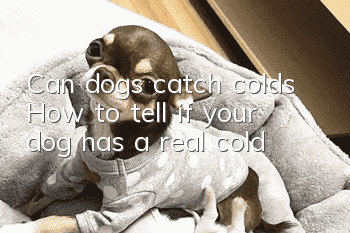Can dogs catch colds? How to tell if your dog has a real cold?

Dog colds are very common, especially in cold and dry seasons, but do dogs really have a cold? In fact, the symptoms of a false cold in dogs are very similar to those of a real cold. The symptoms of a false cold are likely to be caused by dogs. Dogs are a sign of other illnesses, so it’s important to know the symptoms of a real cold in your dog.
What are the symptoms of a real cold?
There are two types of real colds that dogs can get, one is the common cold and the other is the flu.
◆Cold and Flu
Colds and colds often occur in early spring, late autumn and when the climate changes suddenly, and the cause is mostly due to the sudden cold air stimulation of dogs.
For example, being exposed to rain or sleeping in the open in the cold winter, being hit by drafts when sleeping in spring and autumn, using air conditioning in summer, taking a bath when the temperature changes, or the owner not drying the hair in time, etc., will all cause the dog to catch cold and catch a cold.
After catching a cold, dogs become depressed, lose appetite, and sometimes even go on a hunger strike.
When you open a dog's eyes, you will find that its conjunctiva is flushed and its eyes are always "full of tears." If the cold is severe, there will be symptoms such as purulent nasal discharge, accelerated breathing, elevated body temperature, vomiting and diarrhea, and trembling all over. If not treated in time, it is likely to cause bronchitis, respiratory tract infection and other complications.
◆Flu
As the name suggests, influenza is caused by influenza viruses. Dogs are often infected by other dogs carrying the virus when they are playing outside. Like influenza in humans, influenza in dogs is highly contagious. Generally, as long as you come into contact with the feces or smell of a sick dog, you are likely to be infected, and the disease will become rapid and severe.
In addition to the obvious symptoms of a cold, influenza can also cause fever to around 40°C, and the dog's throat will make a dry roar from time to time. The condition usually lasts for 1 to 3 weeks. If not treated in time, it will often cause conjunctivitis. inflammation, enteritis and other diseases.
How to treat a real cold?
To treat a dog's cold, you should first keep the dog in a warm and wind-proof environment. The treatment principles are based on antipyretic, analgesic, and dispelling wind and cold.
If you don’t want to trouble the doctor, you can give your dog oral paracetamol and other drugs, taking 0.5 to 1 gram each time. In order to prevent secondary infection, you can also purchase some antibiotics or sulfonamide drugs. Be careful not to use too high a dose. To be conservative, you can reduce the dose by half as indicated on the instructions.
If the dog is seriously ill, the dog should be sent to the pet hospital for treatment. 5% glucose can be usedMix 250 ml of saline and 2 to 4 ml of gentamicin for intravenous injection. After the condition improves, then switch to drug treatment. In addition, give the dog plenty of water to drink and maintain a quiet environment so that the dog can rest well.
What are the symptoms of a fake cold?
The early symptoms of many infectious diseases in dogs are very similar to colds. For example, canine distemper, parvovirus, etc. mentioned earlier will have symptoms such as elevated body temperature, sneezing, tears, and runny nose. It is easy for people to mistake them for dogs. It is because you have a cold that you delay your condition and miss the best opportunity for diagnosis and treatment.
But after careful observation, you will find that most of these infectious diseases are accompanied by special symptoms. For example, when a dog suffers from canine distemper, its body temperature will fluctuate high and low, showing a two-way fever trend, and there will be a lot of eye droppings; in the early stages of parvovirus, the dog's vomit will have blood streaks and the diarrhea will be colored and thin. These are all It is a symptom that the flu does not have.
- How to deal with a dog's illness?
- How old does a Corgi have to be before he starts gaining weight?
- Key points for diagnosis of canine urinary stones
- What are the common symptoms of dog allergies?
- Emergency treatment for dog fractures
- The feared pit bull, how to train a pit bull not to bite?
- Symptoms and dangers of dog hernia
- Is it good for dogs to eat strawberries?
- very scary! Why does my dog always bark at the open space! ?
- Alert, your dog needs to be dewormed immediately!



